New Jersey Turnpike

New Jersey Turnpike

 New Jersey Turnpike New Jersey Turnpike | ||||||||||
|---|---|---|---|---|---|---|---|---|---|---|
| Route information | ||||||||||
| Maintained by NJTA | ||||||||||
| Length | 117.20 mi[3][5] (188.62 km) | |||||||||
| Existed | 1951–present | |||||||||
| Component highways |
| |||||||||
| Restrictions | Buses and commercial vehicles must use outer roadways between Exits 6 and 14 | |||||||||
| Major junctions | ||||||||||
| South end | ||||||||||
| ||||||||||
| North end | ||||||||||
| Location | ||||||||||
| Counties | Salem, Gloucester, Camden, Burlington, Mercer, Middlesex, Union, Essex, Hudson, Bergen | |||||||||
| Highway system | ||||||||||
New Jersey State Highway Routes
| ||||||||||
The New Jersey Turnpike (NJTP) is a system of controlled-access highways in the U.S. state of New Jersey, maintained by the New Jersey Turnpike Authority (NJTA). The 117.20-mile (188.62 km) mainline's southern terminus is at the interchange with U.S. Route 130 (US 130) and Route 49, where the split of Interstate 295 (I-295) and US 40 occurs, near the border of Pennsville and Carneys Point townships in Salem County, one mile (1.6 km) east of the Delaware Memorial Bridge. Its northern terminus is at US 46 in Ridgefield Park, Bergen County. Construction of the mainline from concept to completion took 23 months, from 1950 to 1952. It was officially opened to traffic in November 1951, between its southern terminus and exit 10.[6]
The turnpike is a major thoroughfare providing access to various localities in New Jersey, as well as Delaware, Pennsylvania, and New York.[7] The toll road provides a direct bypass southeast of Philadelphia for long distance travelers between New York and Washington. According to the International Bridge, Tunnel and Turnpike Association, the turnpike is the nation's sixth-busiest toll road and is one of the most heavily traveled highways in the United States.[8]
The northern part of the mainline turnpike, along with the entirety of its extensions and spurs, is part of the Interstate Highway System, designated as I-95 between exit 6 and its northern end. South of exit 6, it has the unsigned Route 700 designation. There are three extensions and two spurs, including the Newark Bay Extension at exit 14, which carries I-78; the Pennsylvania Turnpike Extension (officially the Pearl Harbor Memorial Turnpike Extension) at exit 6 which carries I-95 off the mainline turnpike; the I-95 Extension from the northern end of the mainline to the George Washington Bridge; and the Eastern Spur and the Western Spur between Newark and Ridgefield. All segments except for the I-95 Extension are tolled.
The route is divided into four roadways between exit 6 and exit 14. The inner lanes are normally restricted to carrying only cars, with the outer lanes for cars, trucks, and buses. The turnpike has 12-foot-wide (3.7 m) lanes, 10-foot-wide (3.0 m) shoulders and 13 rest areas named after notable New Jersey residents. The Interstate Highway System took some of its design guidelines from those for the turnpike.[9] The turnpike is considered iconic in popular culture having been referenced in music, film, and television.
 New Jersey Turnpike New Jersey Turnpike | ||||||||||
|---|---|---|---|---|---|---|---|---|---|---|
| Route information | ||||||||||
| Maintained by NJTA | ||||||||||
| Length | 117.20 mi[3][5] (188.62 km) | |||||||||
| Existed | 1951–present | |||||||||
| Component highways |
| |||||||||
| Restrictions | Buses and commercial vehicles must use outer roadways between Exits 6 and 14 | |||||||||
| Major junctions | ||||||||||
| South end | ||||||||||
| ||||||||||
| North end | ||||||||||
| Location | ||||||||||
| Counties | Salem, Gloucester, Camden, Burlington, Mercer, Middlesex, Union, Essex, Hudson, Bergen | |||||||||
| Highway system | ||||||||||
New Jersey State Highway Routes
| ||||||||||
Route description

Time-lapse video of a southbound trip on the New Jersey Turnpike
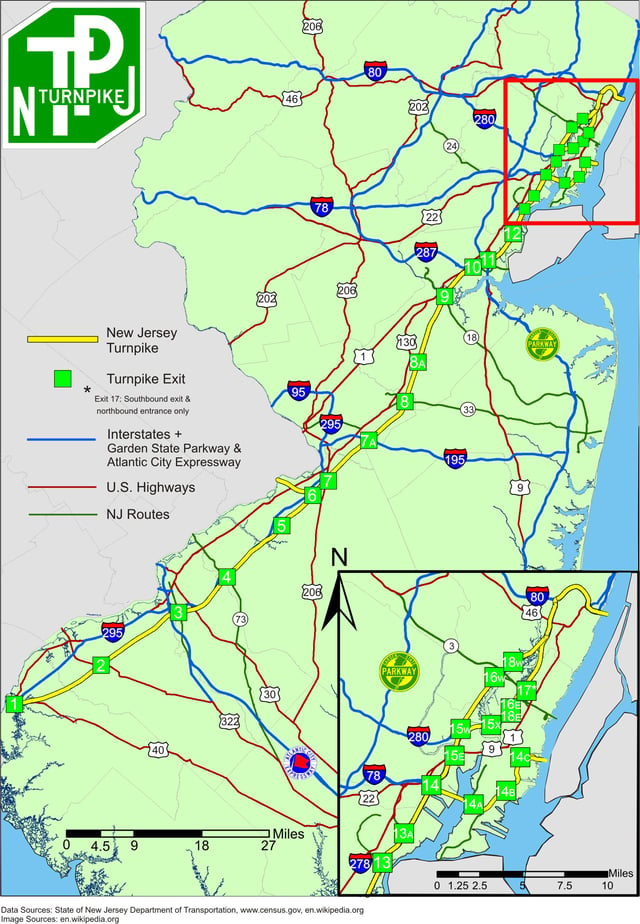
Detailed map of the Turnpike including interchange locations and other surface highways in New Jersey
The mainline of the New Jersey Turnpike splits from I-295 in Carneys Point Township and runs along a north-northeast route to Ridgefield Park, where the road continues as I-95. It is designated Route 700, an unsigned route, from exit 1 (Delaware Memorial Bridge) to exit 6, and as I-95 from exit 6 (Mansfield Township) to exit 18 (Secaucus–Carlstadt). The number of lanes ranges from four lanes south of exit 4 (Mount Laurel Township), six lanes between exit 4 and exit 6 (Mansfield Township), 12 lanes between exit 6 and exit 11 (Woodbridge Township), and 14 lanes between exit 11 and exit 14 (Newark).[10]
Before the advent of the Interstate Highway System, the entire Turnpike was designated by the New Jersey Department of Transportation (NJDOT) as Route 700. The Pennsylvania Turnpike Extension was Route 700P, and the Newark Bay Extension was Route 700N. None of these state highway designations have been signed.
Pennsville to Burlington Township
The turnpike begins within the median of I-295 at exit 1 along the border of Carneys Point and Pennsville Townships, where the northbound lanes of I-295 split to the southeast. Here, the turnpike is cosigned with US 40 and has three three northbound lanes and two southbound lanes. A northbound entrance from Old Pennsville-Auburn Road is provided near an NJDOT fuel station to the south of the highway. Soon afterwards, the turnpike crosses the Salem Canal, and the northbound lanes of I-295 cross over the turnpike. Heading east, US 40 leaves the highway at an interchange with County Route 540 (CR 540). A mile north of this point is the Exit 1 Toll Plaza, where northbound drivers must obtain a ticket, and southbound drivers must surrender their ticket and pay the proper toll. Two Express E-ZPass lanes are provided in each direction. Paralleling I-295, the turnpike continues north/northeast through rural Salem County with two lanes in each direction before approaching the John Fenwick Service Area northbound and the Clara Barton Service Area southbound. After entering Gloucester County the turnpike reaches exit 2 for US 322 in Woolwich Township. The highway then heads northeast past farmland before reaching residential development near Deptford Township. Approaching Bellmawr, the turnpike passes under Route 42 with no access, and then comes to exit 3 for Route 168 (Black Horse Pike). Still two lanes in each direction, the turnpike continues heading northeast and eventually comes within yards of I-295. In Cherry Hill, the turnpike passes under Route 70 with no access, and then enters Mount Laurel and comes to exit 4 for Route 73. North of this point, the turnpike has three lanes in each direction. Still running within close proximity with I-295, the turnpike passes under Route 38 and comes to the northbound James Fenimore Cooper Service Area. The road then crosses over Rancocas Creek and passes to the northwest of Rancocas State Park. Here, the distance between I-295 and the turnpike increases, and the turnpike reaches exit 5 for Burlington-Mount Holly Road (County Route 541). Northeast of here, the turnpike continues as a six-lane highway towards Mansfield.[10]
Mansfield to New Brunswick
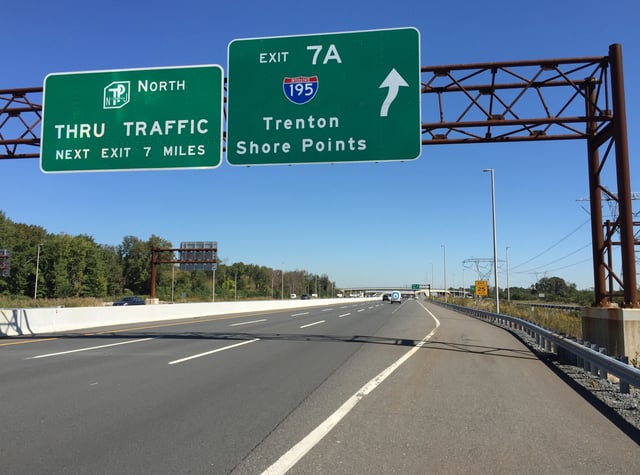
New Jersey Turnpike northbound at I-195 exit in Robbinsville
Beginning just south of exit 6, the turnpike splits into a "dual-dual" configuration similar to a local-express configuration. The outer lanes are open to all vehicles and the inner lanes are limited to cars only, unless signed otherwise because of unusual conditions. Specifically, starting in Mansfield Township (going north), the turnpike has a total of 12 lanes, six in each direction (3-3-3-3). At exit 6, I-95 joins the turnpike. 2 miles (3.2 km) north of here is exit 7, providing access to US 206. Continuing northeast, the Woodrow Wilson and Richard Stockton Service Areas appear on the southbound and northbound sides of the road, respectively, followed by exit 7A in Robbinsville Township for I-195.
The turnpike bypasses the state capital of Trenton to the east. North of I-195, the turnpike passes to the west of several warehouses and traverses rural eastern Mercer County. Near Hightstown, exit 8 is for Route 133, which provides a bypass for Route 33 in the area. North of here, the turnpike changes its course to a slightly more northerly path, and passes more warehouses on both sides of the road. Upon crossing into Middlesex County, suburban development along the corridor greatly increases, indicating the entrance to the New York Metropolitan Area. Exit 8A is for Route 32 and consists of a modified trumpet interchange, with the ramp for traffic seeking Route 32 eastbound forming an "S" shape, taking traffic to Cranbury South River Road. Continuing north, the turnpike encounters more warehouses, the northbound Joyce Kilmer Service Area, and it bisects many residential neighborhoods in the area of East Brunswick. Within this township is exit 9 for Route 18. After exit 9, the turnpike crosses over the Raritan River on the Basilone Memorial Bridge, connecting New Brunswick in the south with Edison in the north. The structure honors John Basilone, a Raritan, resident who is the only United States Marine to be honored with the Medal of Honor, the Navy Cross and the Purple Heart. He died at Iwo Jima in 1945.[11][10]
Edison to Elizabeth

View south along the turnpike from a plane landing at Newark Airport
After crossing the Rartian River and passing through Edison, the turnpike comes to exit 10, serving I-287 and Route 440. Soon afterwards the turnpike enters Woodbridge Township and reaches exit 11, serving the Garden State Parkway and US 9. North of this interchange is the headquarters of the New Jersey Turnpike Authority. From Woodbridge Township to Newark, High-occupancy vehicle lanes (HOV lanes) exist on the outer roadway (truck lanes), thereby making it seven lanes in each direction (4-3-3-4). The HOV restrictions are in effect on weekdays, from 6:00 a.m. to 9:00 a.m. northbound, and 4:00 p.m.–7:00 p.m. southbound (at times, the NJTA might suspend the HOV restrictions entirely during peak hours in case of unusual conditions).[12] After exit 11 is the Grover Cleveland Service Area northbound and the Thomas Edison Service Area southbound. Continuing north, exit 12 serves the municipalities of Carteret and Rahway. Immediately north of exit 12, The Wallberg-Lovely Memorial Bridge carries the turnpike over the Rahway River, and is dedicated to Private Martin Wallberg from Westfield, and Private Luke Lovely from South Amboy, the first soldiers from New Jersey to die in World War I.[13] In Linden and Elizabeth, the turnpike passes to the east of a large industrial park, before reaching exit 13 for I-278, which traverses the nearby Goethals Bridge.[10] A section of the turnpike and the surrounding land in Elizabeth and Newark has been called "the most dangerous two miles in America" by New Jersey Homeland Security officials due to the high volume of traffic and the density of potential terrorist targets in the surrounding area.[14]
Newark to Ridgefield Park
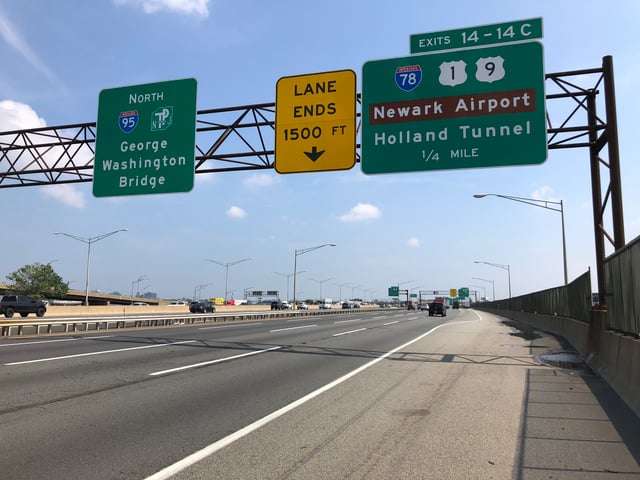
New Jersey Turnpike (I-95) northbound approaching the I-78/US 1–9 interchange in Newark
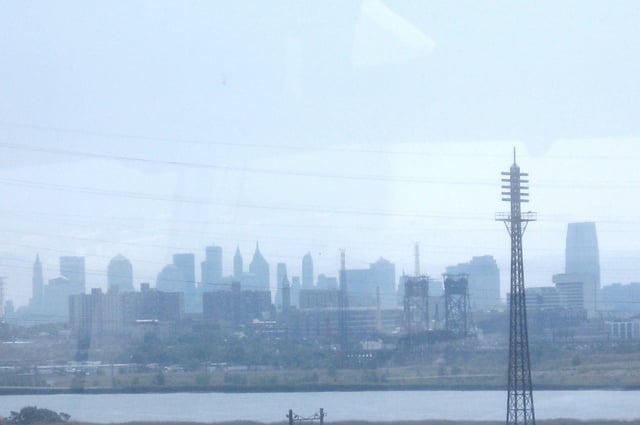
New York City from the New Jersey Turnpike
Exits 13A and 14 both provide access to Newark Liberty International Airport, the eastern end of which the turnpike passes alongside. Exit 14 serves I-78 to the north of the airport. North of exit 14, the turnpike splits into two spurs: the Eastern Spur (the original roadway) and the Western Spur (opened in 1970). Both are signed as I-95. The Western Spur is posted for through traffic on I-95 seeking I-280 and the George Washington Bridge. Traffic seeking US 46, I-80, and the Lincoln Tunnel is routed via the Eastern Spur. NJDOT, which calls every class of highway "Route", calls the Western Spur "Route 95W". The NJTA refers to the complex series of roadways and ramps linking the car–truck lanes, the two spurs, as well as traffic heading to and from both exit 14 and the Newark Bay Extension as the "Southern Mixing Bowl".[15] Both spurs have an exit for US 1/9 at this point. The Lewandowski Hackensack River Bridge carrying the Eastern Spur over the Hackensack River was named in honor of the three Lewandowski brothers, Army Private Alexander, Marine Sergeant Walter and Air Force Lieutenant William, who were killed in action during World War II within 18 months of each other.[16] The Chaplain Washington Bridge, which honors Rev. John P. Washington who gave up his life jacket and died as the SS Dorchester sank on February 3, 1943,[17] and the Harry Laderman Bridge named after the first turnpike employee killed on the job,[16] are steel girder spans that carry the turnpike's eastern and western spurs, respectively, over the Passaic River at Newark. The Eastern Spur provides access to the Secaucus Junction train station and Route 495, and the Western Spur passes by the Meadowlands Sports Complex. Both spurs provide access to Route 3 and the Vince Lombardi Service Area. After the service area, both spurs merge, and the mainline of the turnpike terminates at US 46 in Ridgefield Park, where the road continues as the I-95 Extension of the turnpike.[18]
Extensions
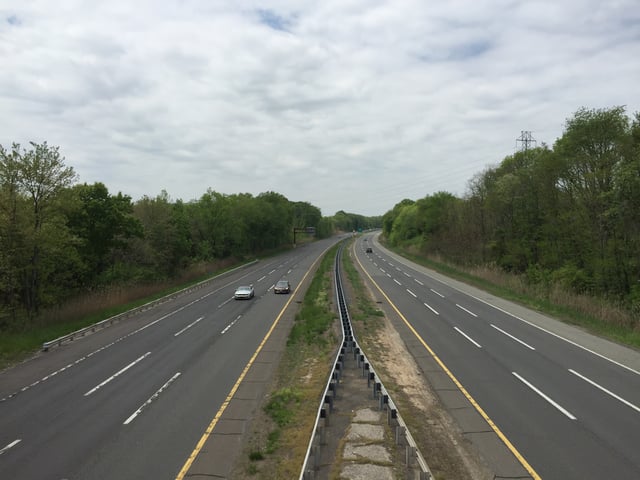
View south along the Pearl Harbor Memorial Turnpike Extension (I-95)
- *See also: §§ Newark Bay Extension andPearl Harbor Memorial Turnpike Extension(below)*
The turnpike has three extensions; the first, the Newark Bay Extension, at 8.2 miles (13.2 km), opened in 1956,[19] and is part of I-78. It connects Newark with Lower Manhattan via the Holland Tunnel in Jersey City and intersects the mainline near Newark Liberty International Airport. This extension has three exits (exits 14A, 14B, and 14C), and due to its design (four lanes with a shoulderless Jersey barrier divider), has a 50-mile-per-hour (80 km/h) speed limit. The extension traverses the Newark Bay Bridge (officially the Vincent R. Casciano Memorial Bridge), which is a steel cantilever bridge spanning Newark Bay and connecting Newark and Bayonne. Dubbed the "world's most expensive road" by The Jersey Journal, it was completed April 4, 1956, as part of the turnpike's Newark Bay Extension. Casciano was a state assemblyman and a lifetime resident of Bayonne.[20]
The second extension, known as the Pearl Harbor Memorial Turnpike Extension (or Pennsylvania Turnpike Connector), carries I-95 off the mainline of the New Jersey Turnpike at exit 6 and connects to the Pennsylvania Turnpike via the Delaware River–Turnpike Toll Bridge, a continuous truss bridge spanning the Delaware River. A six-mile-long (9.7 km), six-lane highway, it has an exit, designated as 6A, to US 130 near Florence. The extension was formerly designated as Route 700P, but was officially designated as I-95 after the Somerset Freeway was cancelled, and was signed as such when the first components of the Pennsylvania Turnpike/Interstate 95 Interchange Project were completed on September 22, 2018.[21]
A four-mile (6.4 km) stretch of I-95 north of US 46 came under NJTA jurisdiction in 1992, as NJDOT sold the road to balance the state budget. This section of the road, known as the I-95 Extension, travels past the interchange for I-80 and through a cut in the Hudson Palisades at GWB Plaza. It ends at US 9W (exit 72), with the final approaches to the George Washington Bridge along I-95 maintained by the Port Authority of New York and New Jersey. This part of the turnpike is split into local and express lanes, as it approaches the George Washington Bridge. Exit numbers along this section follow the mile markers I-95 would have had had the Somerset Freeway been built.[18]
Speed limits
The default speed limit is 65 miles per hour (105 km/h) between the southern terminus and milepost 97, and 55 miles per hour (89 km/h) from there to the northern terminus. The Newark Bay Extension carries a 50-mile-per-hour (80 km/h) limit. The turnpike has variable speed limit signs allowing for the limit to be lowered temporarily during unusual road conditions.[22]
Services
Rest areas
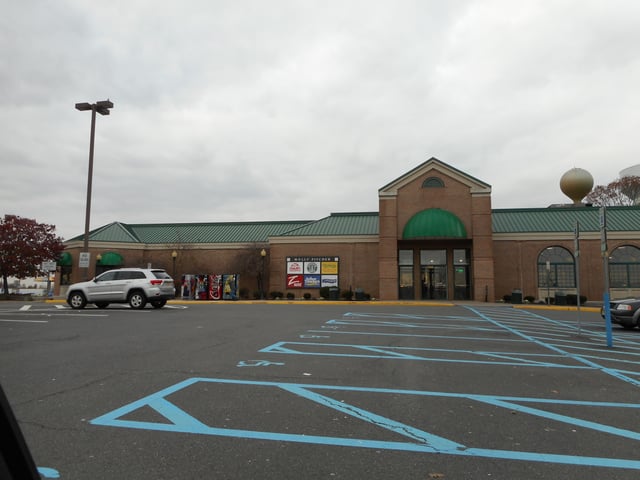
Molly Pitcher Service Area
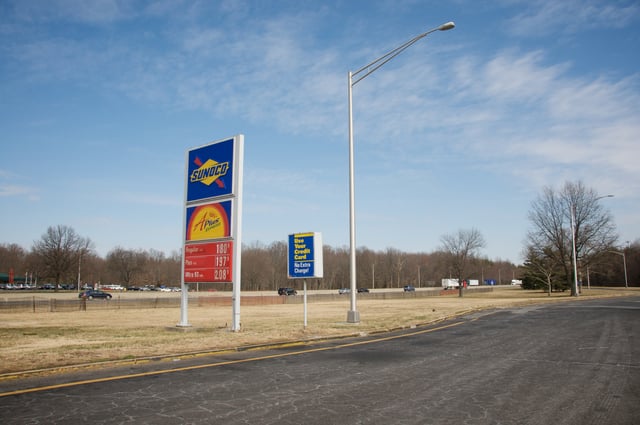
John Fenwick Service Area
The New Jersey Turnpike is noted for naming its rest areas after notable deceased people who had a connection to New Jersey.[23]
| Service area | Direction | mi | km | Nearest exits | Location | Notes |
|---|---|---|---|---|---|---|
| Clara Barton | Southbound | 5.4 | 8.7 | 1, 2 | Oldmans Township | |
| John Fenwick | Northbound | 5.4 | 8.7 | 1, 2 | Oldmans Township | |
| Walt Whitman | Southbound | 30.2 | 48.6 | 3, 4 | Cherry Hill | |
| James Fenimore Cooper | Northbound | 39.4 | 63.4 | 4, 5 | Mount Laurel | |
| Richard Stockton | Southbound | 58.7 | 94.5 | 7, 7A | Hamilton Township | |
| Woodrow Wilson | Northbound | 58.7 | 94.5 | 7, 7A | Hamilton Township | |
| Molly Pitcher | Southbound | 71.7 | 115.4 | 8, 8A | Cranbury | |
| Joyce Kilmer | Northbound | 78.7 | 126.7 | 8A, 9 | East Brunswick | |
| Grover Cleveland | Northbound | 92.5 | 148.9 | 11, 12 | Woodbridge Township | |
| Thomas Edison | Southbound | 92.9 | 149.5 | 11, 12 | Woodbridge Township | |
| Alexander Hamilton | Southbound | 111.6 | 179.6 | 15X, 16E | Secaucus | Eastern spur only |
| Vince Lombardi | Both | 116.0 | 186.7 | 17, 68 | Ridgefield | Eastern and western spurs |
Turnpike rest areas consist mostly of fast food restaurants operated by HMShost. Each rest area also includes restrooms, water fountains, a Sunoco gas station with a small convenience store, with gas price signs posted about half a mile (0.8 km) before reaching the rest area, and a separate parking area for cars and trucks. Some have a dedicated bus parking area, Wi-Fi, and a gift shop as well.[24]
Before 1982, there was a service area on the northbound side named for Admiral William Halsey.[25] However, in 1982, exit 13A was created, which caused the obscuring of the rest area, as they both overlapped with each other. Anyone who wanted to get to the service area missed exiting at exit 13A, and (northbound) drivers who took that exit missed that service area. The service area closed permanently on June 4, 1994.[26] Today, it can be seen by motorists when exiting 13A from the northbound car lanes, where a temporary concrete barrier obstructs an open asphalt lot.[27]
Also, two service plazas were located on the Newark Bay Extension (one eastbound and one westbound) located west of exit 14B. These were closed in the early 1970s. The eastbound plaza was named for John Stevens, the westbound plaza for Peter Stuyvesant.[28]
In late March 2010, it was revealed that the state Transportation Commissioner was considering selling the naming rights of the rest areas to help address a budget shortfall.[29]
The Grover Cleveland Service Area in Woodbridge was temporarily closed because of storm damage from Hurricane Sandy, with only fuel available. It was rebuilt and fully reopened on November 23, 2015.[30][31] In 2015, the NJTA installed Tesla supercharging stations in the Molly Pitcher and Joyce Kilmer services areas to allow Tesla car owners to charge their vehicles. A proposal to offer charging stations for non-Tesla vehicles is also under consideration.[32]
On September 8, 2018, the Thomas Edison service area was closed for remodeling until May 2019.[33]
On January 5, 2019, the Alexander Hamilton Service Area closed for construction. It reopened in August 2019.
On September 6, 2019, the Vince Lombardi Service Area will close for construction. On September 9, the Richard Stockton Service Area will close for construction.
Emergency assistance
The New Jersey Turnpike Authority offers 12-foot-wide (3.7 m) shoulders wherever possible, and disabled vehicle service may be obtained by dialing #95 on a cellular phone.[22]
History
Precursors and planning
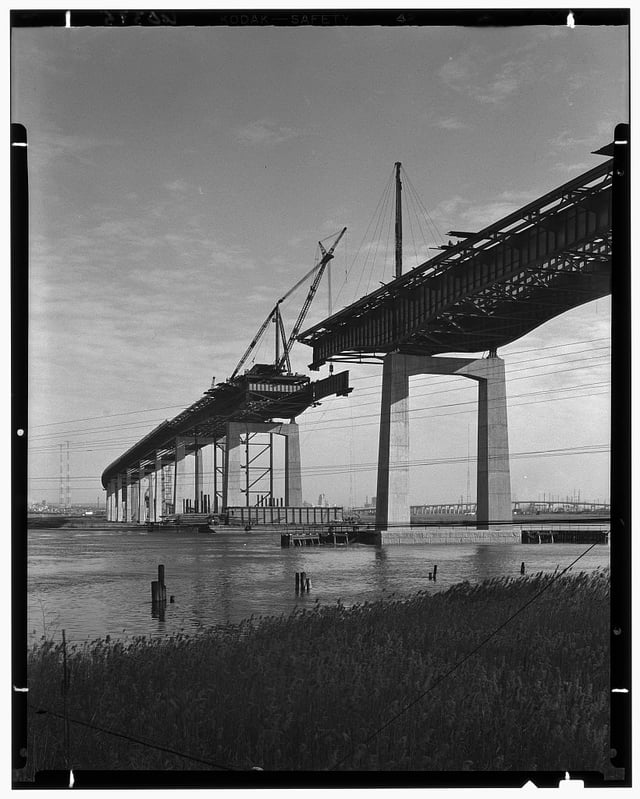
Hackensack Run bridge under construction in 1951
Route 100 and Route 300 were two state highways proposed in the 1930s by the New Jersey State Highway Department as precursors to the New Jersey Turnpike.
The road that is now the New Jersey Turnpike was first planned by the State Highway Department as two untolled freeways in 1938. Route 100 was the route from New Brunswick to the George Washington Bridge, plus a spur to the Holland Tunnel (now the Newark Bay Extension of the Turnpike). Route 300 was the southern part of the turnpike from the Delaware Memorial Bridge to New Brunswick. However, the State Highway Department did not have the funds to complete the two freeways, and very little of the road was built under its auspices.[34][35] Instead, in 1948, the New Jersey Turnpike Authority was created to build the road, and the two freeways were built as a single toll road.
Route S100 was a proposed spur of Route 100 in Elizabeth. It was never built, although Route 81 follows a similar alignment.
According to a letter to the editor written by Kathleen Troast Pitney, the daughter of Paul L. Troast, the first chairman of the New Jersey Turnpike Authority,
Governor Driscoll appointed three men to the turnpike authority in the late 1940s—Maxwell Lester, George Smith and Paul Troast, my father, as chairman. They had no enabling legislation and no funding. They were able to open more than two-thirds of the road in 11 months, completing the whole (project) in less than two years ... When the commissioners broached the subject of landscaping the road ... the governor told them he wanted a road to take the interstate traffic ... off New Jersey's existing roads. Since 85 percent of the traffic at that time was estimated to be from out of state, why spend additional funds on landscaping?[36]
A brochure Interesting Facts about the New Jersey Turnpike, dating from soon after the road's opening, says that when the turnpike's bonds are paid off, "the law provides that the turnpike be turned over to the state for inclusion in the public highway system". Due to new construction, and the expectation that the turnpike pays for policing and maintenance, this has never come to pass.
Construction
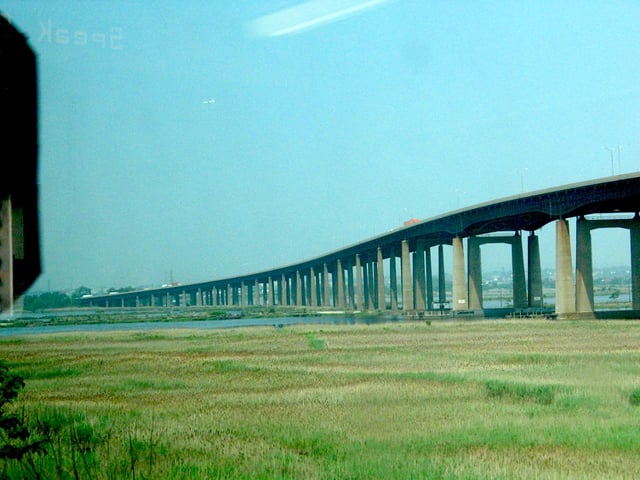
NJ Turnpike passes the swampy Meadowlands, near New York City
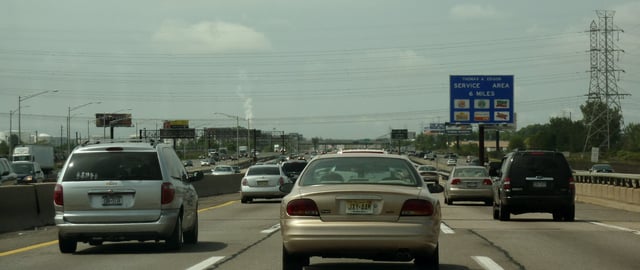
NJ Turnpike southbound just south of exit 13 in Linden, New Jersey
The task of building the turnpike was not an easy one. One major problem was the construction in the city of Elizabeth, where either 450 homes or 32 businesses would be destroyed, depending on the chosen route. The engineers decided to go through the residential area, since they considered it the grittiest and the closest route to both Newark Airport and the Port Newark-Elizabeth Marine Terminal seaport.
When construction finally got to Newark, there was the new challenge of deciding to build either over or under the Pulaski Skyway. If construction went above the skyway, the costs would be much higher. If they went under, the costs would be lower, but the roadway would be very close to the Passaic River, making it harder for ships to pass through. The turnpike was ultimately built to pass under.[37][38] As part of a 2005 seismic retrofit project, the NJTA lowered its roadway to increase vertical clearance and allow for full-width shoulders, which had been constrained by the location of the skyway supports.[39] Engineers replaced the bearings and lowered the bridge by four feet (1.2 m), without shutting down traffic. The work was carried out under a $35 million contract in 2004 by Koch Skanska of Carteret, New Jersey. The project's engineers were from a joint venture of Dewberry Goodking Inc. and HNTM Corp. Temporary towers supported the bridge while bearings were removed from the 150 piers and the concrete replaced on the pier tops. The lowering process for an 800-foot (240 m) section of the bridge was done over 56 increments, during five weeks of work.[40]
While continuing up to the New Jersey Meadowlands, the crossings were harder because of the fertile marsh land of silt and mud. Near the shallow mud, the mud was filled with crushed stone, and the roadway was built above the water table. In the deeper mud, caissons were sunk down to a firm stratum and filled with sand, then both the caissons and the surrounding areas were covered with blankets of sand. Gradually, the water was brought up, and drained into adjacent meadows. Then, construction of the two major bridges over the Passaic and Hackensack Rivers was completed. The bridges were built to give motorists a clear view of the New York City skyline, but with high retaining walls to create the illusion of not being on a river crossing.[41] The 6,955 ft (2,120 m) Passaic River (Chaplain Washington) Bridge cost $13.7 million to build; the 5,623 ft (1,714 m) Hackensack River Bridge cost $9.5 million.
After the turnpike was built in 1952, the NJTA and the New York State Thruway Authority proposed a 13-mile (21 km) extension of the New Jersey Turnpike that would run from its end (at US 46 in Ridgefield Park at the time) up to West Nyack, New York, at I-87, on the New York State Thruway. The section through New Jersey was to be constructed and maintained by the New Jersey Turnpike Authority, while the section in New York was to be built and maintained by the New York Thruway Authority.
The purpose of this extension was to give motorists a "more direct bypass of the New York City area" to New England, by using the Tappan Zee Bridge. The extension was to parallel New York State Route 303 (NY 303) and the present-day CSX River Line, and have limited interchanges. It was to have an interchange with the Palisades Interstate Parkway and at I-87 (New York State Thruway) in West Nyack. This project did not survive; by 1970, it became too expensive to buy right-of-way access, and community opposition was fierce. Therefore, the New Jersey Turnpike Authority and the New York State Thruway Authority cancelled the project.[41]
1950s–1980s
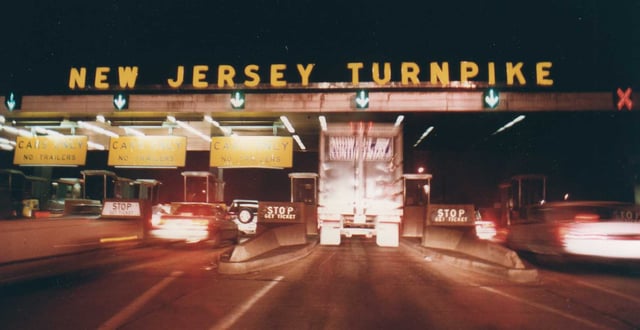
Approaching the exit 11 tollbooths at night in 1992, in the days before E-ZPass
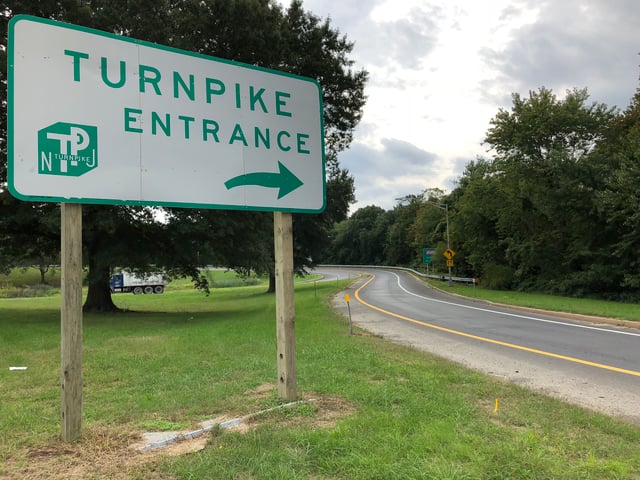
Typical sign at non-freeway entrances to the turnpike
With the turnpike completed, traffic began to increase, which prompted the NJTA's first widening project. In 1955, the authority proposed to widen the turnpike from four lanes to six lanes (three in each direction) between exit 4 in Mount Laurel Township and exit 10 in Woodbridge Township, and from four lanes to an eight-lane, dual-dual setup (2-2-2-2, two express carriageways and two local carriageways in each direction) between exit 10 and exit 14 in Newark.
In 1966, the Turnpike was widened between exit 10 and exit 14 under a new expansion plan. This abolished the express-local roadway plan and created the car and truck-buses lane configuration (3-3-3-3). This project also included closing the old exit 10 at Woodbridge and replacing it with a new exit 10 in Edison Township; exit 11 was also rebuilt to provide complete access to the Garden State Parkway. The dual-dual setup was widened south to exit 9 in East Brunswick Township in 1973, and again extended farther south in 1990 to exit 8A in Monroe Township.[41]
A series of roadway accidents occurred on the New Jersey Turnpike in the town of Kearny, on October 23 and 24, 1973. The first collision occurred at 11:20 p.m. EDT on the 23rd. Further accidents continued to occur until 2:45 a.m. the next day as cars plowed into the unseen accident ahead of them. Sixty-six vehicles were involved, and nine people died as a result. Thirty-nine suffered non-fatal injuries. The primary cause of the accident was related to a fire consisting of burning garbage, aggravated by foggy conditions.[42] This produced an area of extremely poor visibility.
In 1971, the NJTA proposed building the Alfred E. Driscoll Expressway. It was to start at the Garden State Parkway south of exit 80 in Dover Township (now Toms River) and end at the turnpike approximately three miles (4.8 km) north of exit 8A in South Brunswick. As a proposed part of the turnpike system, its seven interchanges would have included toll plazas except at the northern end of the turnpike. By 1972, the proposed road met fierce opposition from Ocean, Monmouth and Middlesex counties with quality of life being the main concern. The NJTA proceeded anyway and began selling bonds. But by December 1973, Governor-elect Brendan Byrne decided to stop the project altogether. Despite this, the authority continued with its plan. It was not until February 1977 that the authority abandoned its plan to build the road.[43] The rights-of-way were sold in 1979, shelving the project indefinitely.[44]
2000s
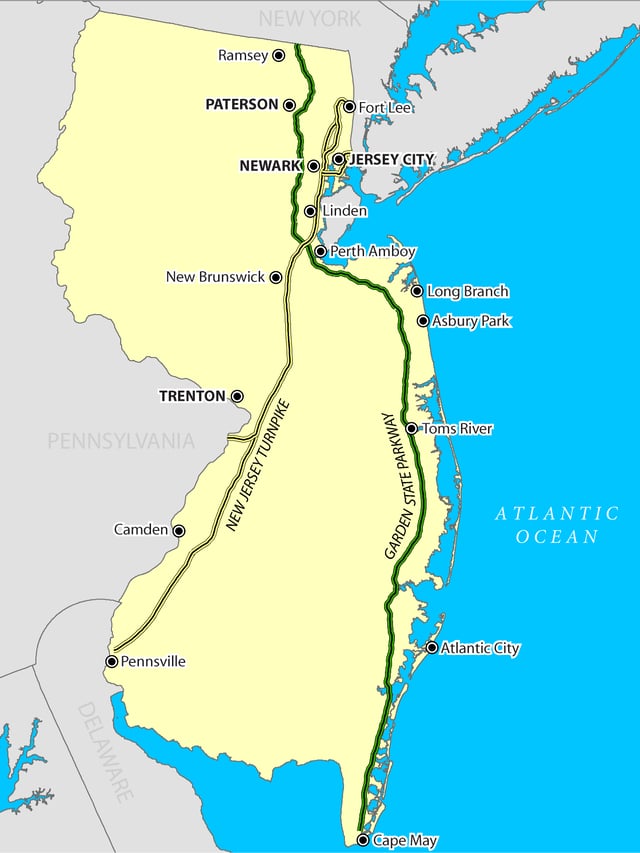
Map of New Jersey Turnpike and Garden State Parkway
In January 2004, the authority opened the refurbished 18W toll gate in Carlstadt. The refurbishment included two E-ZPass Express Lanes in both directions. In July 2004, the New Jersey Turnpike Authority opened the new exit 1 toll gate in Carneys Point Township. The new 23-lane toll gate is near milepost 2.4. It features a glass-enclosed overhead walkway for toll collectors, including "a concrete lighthouse to serve as a 'gateway' to the state as well as to the turnpike".[41] The toll gate features five lanes heading north, 14 lanes heading south, and two E-ZPass Express Lanes in both directions.
In 2005, the authority opened exit 15X to allow access to the newly built Secaucus Junction train station.[45] The authority lowered the Eastern Spur (between mileposts 107.3 and 107.5 in Newark) in 2005. The lowered spur now consists of a minimum 15-foot (4.6 m) vertical clearance and a 12-foot (3.7 m) horizontal clearance on the shoulders underneath the Pulaski Skyway (US 1/9).[41]
In February 2006, the authority updated exit 8A in Monroe Township. The former exit ramp that allowed traffic onto Route 32 westbound, has been closed off. Instead, a new ramp leads to a traffic light at the intersection of the ramp and County Route 535 (CR 535) in South Brunswick Township. CR 535 was expanded between the new ramp intersection and Route 32. The authority planned to build Route 92, an east–west spur from US 1 and Ridge Road in the township of South Brunswick to the mainline of the turnpike at exit 8A in Monroe Township. This proposition was cancelled on December 1, 2006.[46]
Throughout the first decade of the 21st century, the NJTA made repairs to several bridge decks, including the bridge crossing the Rancocas Creek, which was resurfaced in 2007.[47]
The NJTA reconfigured exit 12 in the Borough of Carteret to reduce truck traffic. A new grade separated interchange-ramp was constructed from Roosevelt Avenue east and connects to the toll gate. In addition, the seven-lane toll gate was demolished and replaced with a new 17-lane one. This project was completed in April 2010, five to six months behind schedule.[48] The authority rebuilt exit 16W in the Borough of East Rutherford. Several new ramps were built, and old ones were destroyed. One major modification was destroying the old ramp from the tollgate to Route 3 west and having a new ramp swing around in the opposite direction and merge with Route 3 west, thereby completing the double trumpet-like interchange. This project was completed by March 2010.[49]
2010s
The NJTA began accepting E-ZPass on all toll lanes at all turnpike interchanges on March 5, 2011.[50] On April 28, 2011, attempts to privatize toll collection on the New Jersey Turnpike were thwarted as a deal between the New Jersey Turnpike Authority and two unions to reduce toll collector salaries was made instead.[51] The Authority reconstructed the Route 495 westbound overpass across the turnpike at exit 16E in Secaucus. This was finished in the middle of 2011.[52]
On March 31, 2014, the NJTA began a new lane control system on the eastbound lanes of the Newark Bay–Hudson County Extension. This system used the shoulder as a travel lane between exit 14 to 14C.[55] This system was discontinued on May 20, 2019 as part of a bridge redecking project, and the shoulder is no longer used as a travel lane.[56]
Widening between interchanges 6 and 9
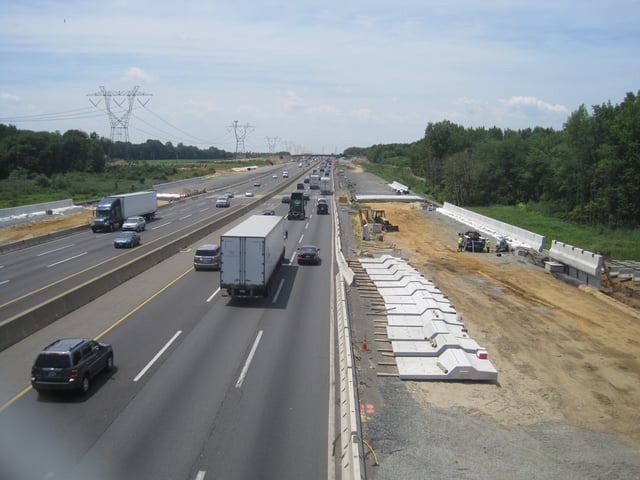
Construction of the new lanes as seen in Robbinsville Township in July 2012
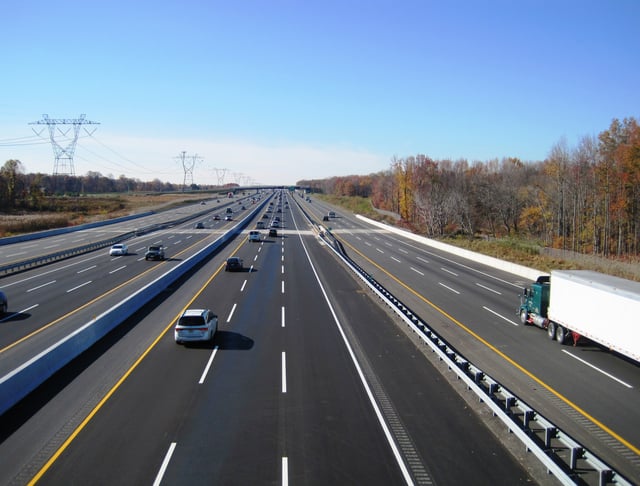
Completed 12-lane roadway from same point as above in November 2014
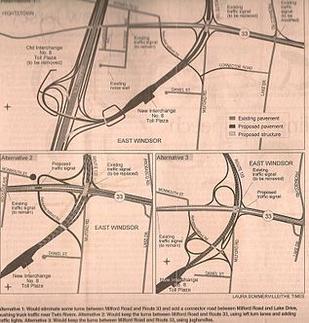
Three proposals for new exit 8 in East Windsor. Alternative 1 was chosen (with a few changes)
In November 2004, Governor Richard Codey advocated a plan to widen the turnpike by extending the dual-dual configuration 20.1 miles (32.3 km) south from exit 8A in Monroe Township to exit 6 in Mansfield Township. This was to be completed by 2014 when Pennsylvania was supposed to finish an interchange, that would connect its turnpike to the existing I-95 in Bristol Township, Pennsylvania. Finances were to be supplied by rerouting money from the planned Route 92 Turnpike extension.[57] As part of this project, the NJTA expanded the turnpike by changing the dual-dual configuration (from 2-3-3-2 to 3-3-3-3) between exit 9 in East Brunswick Township and exit 8A in Monroe Township. Minimal construction was needed since overpasses were already built with future expansion in mind. Only final preparation and paving of an outer lane in the outer roadways were required to accommodate the extra lane. New signage and lighting were installed as part of the widening project. It was thought that some transmission towers that ran near the turnpike would have to be reconfigured to make room for the newly constructed roadways. However, this idea was dismissed because it would have been cost prohibitive, and the towers, in fact, did not need to be relocated.[58] The widened turnpike features six lanes in each direction (3-3-3-3), double the previous capacity.[59][60] The following interchanges were upgraded with this widening project: exit 6 (Mansfield), exit 7 (Bordentown Township), exit 7A (Robbinsville), exit 8 (East Windsor), and exit 8A (Monroe).[61]
On July 2, 2009, a ceremonial groundbreaking took place near exit 8 to initiate the widening of the turnpike.[62] On January 28, 2014, the last two of the project's 31 construction contracts was awarded.[63] On May 17–18, 2014, the NJTA switched traffic from the inner roadway for the new outer roadway to do repairs and resurfacing of the inner roadway.[64] A total of six northbound lanes between exits 6 and 9 opened on October 26, 2014, while the southbound lanes opened a week later on November 3, 2014. The final cost reported to be $2.3 billion.[65][66] The project employed 1,000 workers a day, and at one point was the largest active road construction project in the Western Hemisphere.[67]
In late October 2015, the southbound inner roadway exit ramp at exit 7A was closed to make repairs to the overpass crossing over the truck lanes. Steel plates beneath the deck of the exit ramp overpass "were not built to specification" when it was originally constructed. The ramp was reopened in late November 2015.[68]
| Exit | Interchange/Toll Gate Location | Mile | Ramp Modifications | Expansion to toll gate | Notes | Start of Construction |
|---|---|---|---|---|---|---|
| 6 | Mansfield Township | 50.9 | Build two-lane high-speed ramps to/from inner and outer roadways | No | Southern end of "dual–dual" setup | late 2009 |
| 7 | Bordentown Township | 53.7 | Build single lane ramps to/from inner and outer roadways | No | mid-2009 | |
| 6N & 6S | Hamilton Township | 57.8 | Build single lane inner and outer roadway exit/entrance ramps | — | Woodrow Wilson Service Area (6N) & Richard Stockton Service Area (6S) | late 2009 |
| 7A | Robbinsville Township | 60.5 | Build new ramps to inner and outer roadways | Yes—add three more lanes to gate | Two-lane ramps to be built to enter northbound lanes and exit southbound lanes and single lane ramps to enter southbound lanes and exit northbound lanes | mid-2009 |
| 8 | East Windsor Township | 67.6 | Build new interchange with single lane ramps to/from inner and outer roadways, and ramp to maintenance shed | Yes—new 12-lane toll gate | New exit 8 was constructed east of the Turnpike, connecting directly to the Hightstown Bypass and Route 33 | mid-2009 |
| 7S | Cranbury Township | 71.5 | Build single-lane southbound ramps to/from inner & outer roadways | — | Molly Pitcher Service Area on the southbound side | early 2010 |
| 8A | South Brunswick/Monroe Township | 73.9 | Build single-lane entrance ramp to southbound inner car lanes | No | early 2010 |
On January 1, 2007, the NJTA released its plan for exit 8 in East Windsor Township. The old interchange, located west of the turnpike, was demolished and replaced with a new one located to the east of the turnpike. The new interchange configuration opened in January 2013, featuring a new toll plaza consisting of 10 lanes, with direct access to the Route 133 (Hightstown Bypass) without going through any traffic lights, as well as to Route 33 by using a grade-separated interchange.[69] Construction of a realigned Milford Road, near the interchange, was open to traffic in October 2011.[70] Milford Road was converted into an overpass crossing over the new interchange 8 ramp. The junction with the realigned Milford Road, Route 33 and Monmouth Street was also modified.[71]
Other construction
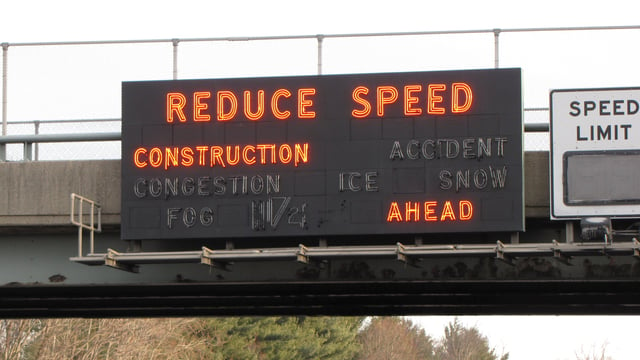
An older variable-message sign displaying a warning. These signs have since been replaced.
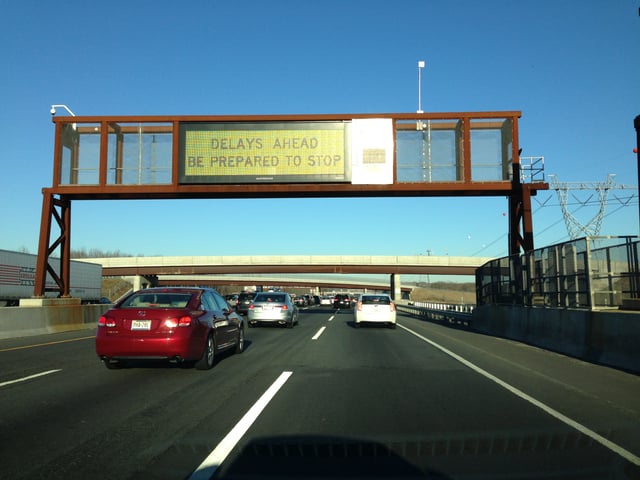
A newer VMS displaying a warning about congestion ahead
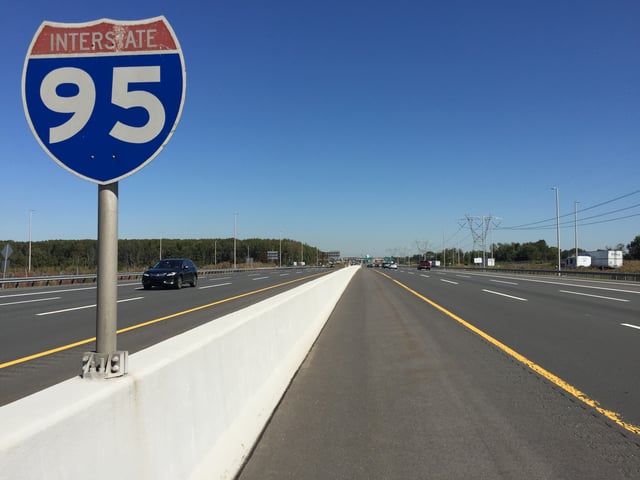
View north along the New Jersey Turnpike in Hamilton Township, Mercer County. This was one of the southernmost I-95 signs on the mainline New Jersey Turnpike before the completion of I-95 in September 2018.
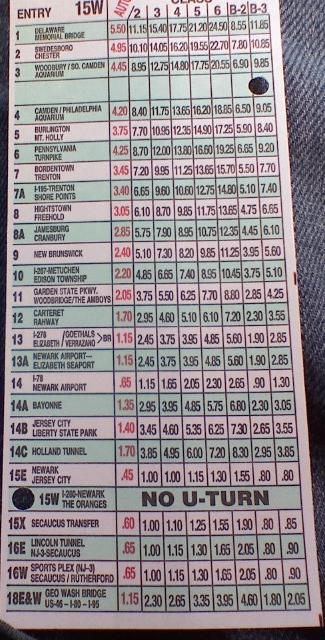
A toll ticket received at exit 15W in 2008
Due to traffic congestion outside exit 8A, the NJTA plans to improve Route 32 from its intersection at US 130 in South Brunswick to the exit 8A tollgate in Monroe Township. Named the "Interchange 8A to Route 130 Connection", plans and dates have yet to be determined.[72]
The authority is planning a 1.1-mile (1.8 km) roadway and bridge, called the "Tremley Point Road Connector", from Industrial Highway in the Borough of Carteret to Tremley Point Road in the City of Linden. The purpose of this project is to increase truck access to the Tremley Point industrial area in Linden while moving trucks off local streets in residential neighborhoods. The authority chose this access road rather than a full interchange with Tremley Point Road from the turnpike mainline because of its proximity to both exits 12 and 13.[77] The estimated completion date of the connector has yet to be determined,[78] and as of August 2016, no construction contracts had been awarded.[79]
In conjunction with the Port Authority of New York and New Jersey's replacement of the Goethals Bridge, improvements are being studied at exit 13 in Elizabeth and Linden.[80]
The authority plans to improve exit 14A in Jersey City and connecting roads in Bayonne because the current interchange is in "poor condition" and suffers from chronic congestion. This is part of a bigger project that addresses future congestion along Route 440. Official groundbreaking occurred on March 11, 2015, with an expanded toll plaza and connector bridge targeted for completion in late 2018 with a $310 million budget.[81][82] The newly expanded exit 14A reopened in May 2018 ahead of its anticipated opening later in the year.[83]
All of the turnpike's original variable-message signs (VMS) were replaced from 2010 to 2015, and many new signs were also added. The replacement signs, which feature full graphic color matrix technology, are more up-to-date and feature travel times to major routes when not otherwise in use.[84]
Tolls
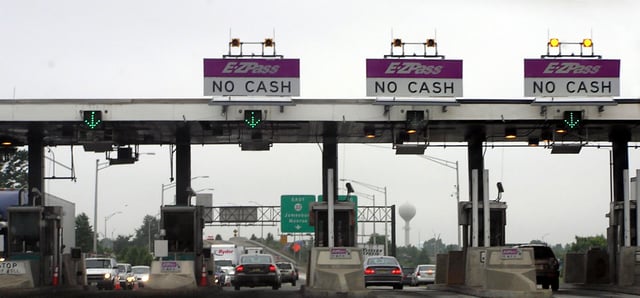
A New Jersey Turnpike Tollgate for exit 8A in Monroe Township
The New Jersey Turnpike is a closed-system toll road, using a system of long-distance tickets, obtained once by the motorist upon entering and surrendered upon exiting at toll gates. The toll fee depends on the distance traveled—longer distances result in higher tolls. As of 2012, the automobile toll from exit 1 to exit 18 is $13.85.[85] If the ticket is lost, the driver must pay the highest toll fee upon exiting. In September 2000, the turnpike introduced E-ZPass electronic toll collection.[86] Discounts were available to all users of the E-ZPass system until 2002. Since then, the costly implementation of the E-ZPass system forced the NJTA to eliminate the discounts during peak hours and instead impose a $1 per month E-ZPass fee to their account holders. E-ZPass customers with NJ accounts still receive a discount during off-peak hours,[87] when the automobile toll from exit 1 to exit 18 is $10.40. Cash customers do not receive this discount.[88] Three toll plazas on the turnpike have Express E-ZPass lanes, allowing E-ZPass customers to travel through toll areas at highway speeds, thanks to the addition of E-ZPass sensors on an overhead gantry. These high-speed toll gates are located at the northern terminus of the road on the Western Spur, the southern terminus in Carneys Point, and on the Pennsylvania Turnpike Extension. At each location, traditional E-ZPass and cash lanes are also available. Every toll lane on the turnpike accepts E-ZPass.
When traveling from the north, drivers who exit from the southbound Western Spur onto the ramp for dedicated access to the Meadowlands Sports Complex pay no toll, but the NJTA counts cars electronically and is paid a fee for each vehicle by the New Jersey Sports and Exposition Authority.
The non-tolled I-295, which parallels the turnpike for much of its southern length, is often used as an alternate route for shunpiking by locals and through travelers alike; before the expansion of the exit 1 toll plaza, this route was promoted through signage and radio announcements from the New Jersey State Police as a bypass of summer congestion at the plaza.
Exit list
Mainline, Eastern Spur, and I-95 Extension
| County | Location | mi[3][5] | km | Exit | Destinations | Notes |
|---|---|---|---|---|---|---|
| Salem | Pennsville Township | 0.00 | 0.00 | – | Southern terminus; southern terminus of concurrency with I-295 / US 40 | |
| 0.22 | 0.35 | 1A | Signed as exit 1 southbound; western terminus of Route 49 | |||
| 1B | No southbound exit; southern terminus of US 130 | |||||
| Carneys Point Township | 0.72 | 1.16 | – | Northern terminus of concurrency with I-295; northbound exit and southbound entrance | ||
| 1.12 | 1.80 | – | Northern terminus of concurrency with US 40 | |||
| 2.40 | 3.86 | Exit 1 Toll Plaza | ||||
| Gloucester | Woolwich Township | 12.80 | 20.60 | 2 | ||
| Camden | Runnemede–Bellmawr borough line | 26.10 | 42.00 | 3 | ||
| Burlington | Mount Laurel Township | 34.50 | 55.52 | 4 | ||
| Westampton Township | 44.10 | 70.97 | 5 | CR 541 – Burlington, Mount Holly | ||
| Mansfield Township | 48.70 | 78.38 | Southern terminus of dual-roadway setup (inner roadway for cars, outer roadway for cars, trucks, and buses) | |||
| 51.00– 51.60 | 82.08– 83.04 | 6 | Eastern terminus of Pearl Harbor Extension; south end of I-95 overlap | |||
| Bordentown Township | 53.30 | 85.78 | 7 | Interchange reconstructed in 1990[41] | ||
| Mercer | Robbinsville Township | 60.50 | 97.37 | 7A | Interchange modified 2013–2014 | |
| East Windsor Township | 67.50 | 108.63 | 8 | Interchange reconstructed in 2013–2014 | ||
| Middlesex | Monroe Township–South Brunswick Township township line | 73.90 | 118.93 | 8A | ||
| East Brunswick Township | 83.40 | 134.22 | 9 | Interchange modified in 2017. | ||
| Raritan River | 84.22 | 135.54 | Basilone Memorial Bridge | |||
| Edison Township | 88.10 | 141.78 | 10 | Southern terminus of I-287 and Route 440[1] | ||
| Woodbridge Township | 91.00 | 146.45 | 11 | [1] | ||
| Carteret | 95.90 | 154.34 | 12 | CR 602 – Carteret, Rahway | ||
| Union | Elizabeth | 99.40 | 159.97 | 13 | ||
| 101.60 | 163.51 | 13A | ||||
| Essex | Newark | 104.70 | 168.50 | 14-14C | Western terminus of the Newark Bay Extension | |
| 105.60 | 169.95 | – | Southern terminus of the Western Spur | |||
| 106.90 | 172.04 | 15E | ||||
| Hudson | Kearny | 108.50– 108.80 | 174.61– 175.10 | 15W | Southbound exit and northbound entrance; eastern terminus of I-280 | |
| Secaucus | 110.80 | 178.32 | 15X | Secaucus | Access to Secaucus Junction | |
| 112.30 | 180.73 | Exits 16E / 18E Toll Plaza | ||||
| 112.70 | 181.37 | 17 | Interchange rebuilt in 1964;[89] signed as exit 16E northbound; western terminus of Route 495 | |||
| Bergen | Ridgefield Park | 117.20– 116.80 | 188.62– 187.97 | – | Northern terminus of the Western Spur | |
| 117.20 | 188.62 | 68 | Rebuilt in 1971 in conjunction with exit 69; exit number only signed southbound, no northbound access to Teaneck Road | |||
| 117.80 | 189.58 | 68 | Challenger Road | Northbound exit only | ||
| Southern end of express (upper) lanes and local (lower) lanes | ||||||
| Teaneck Township | 119.00 | 191.51 | 69 | Exit number only signed southbound; eastern terminus of I-80 | ||
| 119.40 | 192.16 | 70 | CR 56 – Leonia, Teaneck | Signed into exits 70A (Leonia) and 70B (Teaneck) northbound | ||
| Englewood | 120.90 | 194.57 | 71 | Broad Avenue – Leonia, Englewood | Northbound exit and southbound entrance | |
| Fort Lee | 121.50– 121.80 | 195.54– 196.02 | 72A | Southbound exit and northbound entrance; eastern terminus of Route 4 | ||
| 122.40 | 196.98 | 72 | Northern terminus; southern terminus of US 9W | |||
| – | Continuation beyond Fort Lee Interchange | |||||
1.000 mi = 1.609 km; 1.000 km = 0.621 mi
| ||||||
Pearl Harbor Memorial Turnpike Extension
- *See also:§ Extensions(above)*
The entire route is in Burlington County.
| Location | mi[3][5] | km | Exit | Destinations | Notes |
|---|---|---|---|---|---|
| Delaware River | 0.00 | 0.00 | – | Continuation into Pennsylvania at river's center | |
| Delaware River–Turnpike Toll Bridge | |||||
| Florence Township | 2.60 | 4.18 | 6A | Exit number unsigned; tolled westbound entrance; upgraded in 1999.[89] | |
| Toll Plaza | |||||
| Mansfield Township | 6.55 | 10.54 | 6 | Exit 6 on NJ Turnpike | |
1.000 mi = 1.609 km; 1.000 km = 0.621 mi
| |||||
Newark Bay Extension
- *See also:§ Extensions(above)*
| County | Location | mi[3][5] | km | Exit | Destinations | Notes |
|---|---|---|---|---|---|---|
| Essex | Newark | 0.00 | 0.00 | 14 | Western terminus of concurrency with I-78 | |
| Exit 14 Toll Plaza | ||||||
| – | Exit 14 on I-95 / Turnpike | |||||
| Hudson | Jersey City | 3.50 | 5.63 | 14A | Interchange reconstructed 2015–2018 | |
| 5.50 | 8.85 | 14B | Bayview Avenue – Jersey City, Liberty State Park | |||
| 5.90 | 9.50 | Exit 14C Toll Plaza | ||||
| 14C | Eastern terminus of concurrency with I-78 | |||||
1.000 mi = 1.609 km; 1.000 km = 0.621 mi
| ||||||
Western Spur
| County | Location | mi[3][5] | km | Exit | Destinations | Notes |
|---|---|---|---|---|---|---|
| Essex | Newark | 105.60 | 169.95 | – | Southern terminus of the Western Spur | |
| 106.90 | 172.04 | 15E | Southbound exit and northbound entrance | |||
| Hudson | Kearny | 108.50– 108.80 | 174.61– 175.10 | 15W | Eastern terminus of I-280 | |
| Bergen | East Rutherford | 112.70 | 181.37 | 16W | ||
| Carlstadt | 113.80 | 183.14 | Exit 18W Toll Plaza (George Washington Bridge) | |||
| 114.07– 114.55 | 183.58– 184.35 | – | Sports Complex | No northbound exit; open during events only | ||
| Ridgefield Park | 117.20 | 188.62 | 69 | No exit number northbound | ||
| 116.80 | 187.97 | – | Northern terminus of the Western Spur | |||
1.000 mi = 1.609 km; 1.000 km = 0.621 mi
| ||||||
In popular culture
One of the promotional taglines in the 1988 film Moving is "On the New Jersey Turnpike, no one can hear you scream."
In the 1999 film Being John Malkovich, characters are transported into the mind of actor John Malkovich and after 15 minutes are suddenly dropped in a ditch beside the New Jersey Turnpike.[90]
In "The State Dinner", a 1999 episode of The West Wing, Leo McGarry responds to a truckers union representative, after the latter uses inappropriate language, by saying "This is the White House, it's not the Jersey Turnpike."[91]
Much of the opening credits of The Sopranos consists of shots of or from the New Jersey Turnpike in the areas of exits 12, 13, 14-14C, and 15W.[92]
Bruce Springsteen's songs "State Trooper" and "Jungleland", describe someone driving the New Jersey Turnpike.[93]
Simon and Garfunkel's song "America" contains the lyric, "counting the cars on the New Jersey Turnpike".[7]
Chuck Berry's 1956 song "You Can't Catch Me" features the lyrics "New Jersey Turnpike in the / wee wee hours I was / rolling slowly 'cause of / drizzlin' showers."
The Dead Milkmen's 1986 album Eat Your Paisley contains the instrumental song "Vince Lombardi Service Center" as a bonus track on the CD.[94]
In Need for Speed: The Run, a racing event starts on the Newark Bay Extension on exit 14B just before going into Jersey City and Liberty State Park. That ends in the Holland Tunnel as the driver (who is the player of that game) is chased by the Police while driving into New York City.[95]
Cherry Hill-based Flying Fish Brewing makes the "Exit Series" of beers, which are named in honor of the exits of the Turnpike, with each beer intended to be reminiscent of the communities in or near where the relevant exit sits.[96]
The song "Where I Come From" by Country singer Alan Jackson begins with the lyrics "Well I was rollin' wheels and shiftin' gears 'round that Jersey Turnpike."
The character "Paulie Herman" from the TV series Saturday Night Live, played by Joe Piscopo, was known for a sketch from 1981 in which he says "Are you from Jersey? I'm from Jersey. What exit?", referring to exits on the New Jersey Turnpike and the Garden State Parkway.[97][98]
See also
[[INLINE_IMAGE|//upload.wikimedia.org/wikipedia/commons/thumb/c/c3/Blank_shield.svg/29px-Blank_shield.svg.png|//upload.wikimedia.org/wikipedia/commons/thumb/c/c3/Blank_shield.svg/43px-Blank_shield.svg.png 1.5x, //upload.wikimedia.org/wikipedia/commons/thumb/c/c3/Blank_shield.svg/58px-Blank_shield.svg.png 2x|Blank shield.svg|h28|w29|noviewer]] U.S. Roads portal
[[INLINE_IMAGE|//upload.wikimedia.org/wikipedia/commons/thumb/9/92/Flag_of_New_Jersey.svg/32px-Flag_of_New_Jersey.svg.png|//upload.wikimedia.org/wikipedia/commons/thumb/9/92/Flag_of_New_Jersey.svg/48px-Flag_of_New_Jersey.svg.png 1.5x, //upload.wikimedia.org/wikipedia/commons/thumb/9/92/Flag_of_New_Jersey.svg/64px-Flag_of_New_Jersey.svg.png 2x|Flag of New Jersey.svg|h19|w32|noviewer flagicon-img]] New Jersey portal


